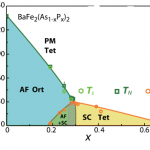Nematic Fluctuations and Quadrupolar Relaxation
Our work on the iron pnictide superconductors has

been published in Physical Review Letters. Superconductivity can be induced by substituting phosphorus for the arsenic in the material BaFe2(As,P)2, as seen the in the phase diagram at right. The blue region corresponds to antiferromagnetic order in the nematic phase, and the yellow region corresponds to superconductivity. Our NMR measurements probe the fluctuations of the magnetic and nematic order parameters across the various phase transitions. As the temperature approaches the phase transition temperature, long-wavelength slow fluctuations of the order parameter emerge, reflecting critical slowing down. There are both antiferromagnetic fluctuations present, as well as nematic charge fluctuations. The nematic fluctuations break the four-fold symmetry of the unit cell, and exhibit two-fold symmetry. This low symmetry creates a different charge pattern around the As and P nuclei. The antiferromagnetic fluctuations create time-dependent magnetic fields at the nuclei, whereas the nematic fluctuations create time-dependent charge fluctuations.

The As-75 nucleus has spin 3/2, and a large quadrupolar moment. It ‘feels’ the charge fluctuations associated with the nematic order. The P-31 nucleus has spin 1/2, and is completely insensitive to the charge fluctuations. Therefore, by comparing the As and the P results, we can disentangle the separate contributions of the spin and charge fluctuations present. The nuclear spin-lattice relaxation rate shown at left is different for these two sites. We find that the As-75 senses an extra relaxation channel arising from the nematic fluctuations. These critical fluctuations slow down as the nematic phase transition approaches. In the superconducting sample, the nematic fluctuations are also present, even though there is no long-range nematic order. This result suggests that nematic fluctuations may help stabilize superconductivity in these materials.
